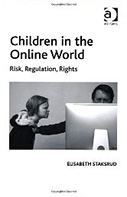Children in the Online World: Risk, Regulation and Rights

Author: Elisabeth Staksrud
Publisher: Farnham, Surrey, UK; Burlington, VT: Ashgate Publishing Limited, 2013. 240p.
Reviewer: Anne-Marie McAlinden | January 2014
The issue of children’s use of the internet and more particularly their safety in the virtual environment has featured heavily in contemporary public and political discourses. Academic discourses on the subject have cut across a range of distinct literatures from child protection and offending behaviour, media and communication studies, to regulatory approaches. These discourses have involved a range of related disciplines including education, law, sociology, psychology and criminology. Within these broader contexts, the voices of children themselves and more particularly their rights in the on-line world, aside from the risks they may face, have been little considered. As the title itself conveys, Elisabeth Staksrud takes up this challenge in examining the issue of children and on-line risk using the three inter-related concepts of risk, regulation and rights. To elaborate a little further, her tri-partite conceptual framework focuses on three key issues – on-line risks faced by children and the ‘risky decisions’ they may make themselves; systemic and transnational regulations governing children’s use of the internet; and the implications, which concerns about regulations and risk have for children’s rights.
The three central research questions for the book identified by the author at the outset (p 4) are: 1. What is online risk? 2. How is online risk regulated? and 3. What are the potential implications for children’s rights? While other quantitative studies, as the author notes, have also tried to capture or measure online risks to children, it is the second and third of these concerns which are theoretically interesting and of contemporary significance to both scholars and policy makers in this area. Detailed consideration of these two issues marks this book as making a distinct and novel contribution to debates concerning children and the on-line world. That is, the book not only furthers existing debates on risk and regulation concerning children’s use of the internet, but it also has potential practical implications for how society and policy makers approach this problem.
Following the introductory chapters, the book is divided into three parts with one part devoted to each of the three research questions. Part I conceptualises risk; Part II is devoted to the issue of regulation and Part III to rights. One of the great strengths of the book is its utilization of the theoretical framework on risk and in particular Beck’s concept of institutionalized individualization which is carried throughout. Broadly speaking, the individualization thesis, as Staksrud acknowledges, is the often neglected but much criticised element of Beck’s broader ‘risk society’ paradigm. This thesis focuses on the forced nature of individual decision making (in this case children and their parents or caregivers) which is imposed by institutions. Staksrud however, addresses what she terms a ‘blind spot’ in Beck’s theory which does not actually consider children as relevant subjects. This broad framework is used to inform the argument that individuals can and do make decisions about online risk and about engaging in risky behaviour. In Part I Staksrud utilises a general typology of risk and observes risk in its historical context as the latest manifestation of technological risk. The typology highlights a wide spectrum of on-line risks concerning children from peer-related risks such as bullying to commercial exploitation or sexual abuse or exploitation. The author examines public perceptions and anxieties about online risks concerning children, which are typically narrowly framed, and the need to protect them, and documents how this helps inform resultant debates about regulation. These expectations also have implications for the choice of regulatory approaches adopted and their perceived legitimacy.
In Part II, in taking Beck’s thesis further, the author notes how what has been termed ‘the precautionary principle’ by a range of scholars in the area of risk, has also held sway within and across the European Union. She analyzes the key supranational regulatory approaches to on-line risks concerning children primarily within the context of pan-European approaches to risk across ‘the Western welfare states of Europe’ and the European Commission’s Safer Internet Programme. Five distinct policy pillars of the management of online risks to children within the European Union are identified. These are: legislation, hotlines, self-regulation, filtering and content classification, and awareness raising. Returning to the rubric of Beck’s individualization thesis, the author documents changes in the ‘societal semantics of law’ and ‘the outsourcing of governmental functions on a national level’ to NGOs, the internet industry and internet users themselves as key legal and practical effects of European regulatory policies on online risk. As a bridge to the final part of the book, the author argues that these key changes may undermine regulatory legitimacy and create a tension between the competence and decision making powers of individuals, namely children and their parents.
Finally, in Part III, Staksrud draws out the implications of the previous two sections for children’s rights. She argues that current regulatory policies and frameworks which seek to govern online risks to children put pressure on children’s rights and transform them from ‘digital citizens’ with subjective or standard rights within civil society to ‘digital consumers’ whose rights are ultimately dependent on their relationship with the online product or service provider.
At the heart of the book, and the final part in particular, is the delicate balancing exercise to be performed between the boundaries and limitations of the governance of risk and the impact of these parameters on fundamental human rights. The protection of children is a key rationale underlying regulatory approaches to risk concerning potentially harmful behaviours towards children. The problem with such approaches as Staksrud succeeds in underlining is that they often challenge the basic human rights of those who are subject to such regulatory approaches – whether perpetrators or victims. Scholars in the area of offender risk management have highlighted this dichotomy more generally in relation to the effects of precautionary policies on risk, on offender rehabilitation and reintegration. Staksrud makes an important contribution to these broader debates about the cautionary tales within pre-emptive approaches to on-line risks concerning children by underlying the potentially harmful effects for children themselves and the need to protect them at all costs. It highlighting this important tension between control and freedom, she highlights the potential impact of risk regulation on the human rights and civil liberties of children themselves such as internet use, freedom of information, participation and expression.
The book provides new insights into an area that is contemporary and constantly evolving. Its unique contribution, as noted above however, is in highlighting the ‘rights’-based discourses and the voices of children themselves and, importantly, how these may be impacted and undermined by social and political concerns with ‘risk’ and ‘regulation’ relating to children in the on-line world. Given the growth in regulatory policies concerning the need to manage risks to children both in the virtual and the real world, the book conveys the important message that in carrying out our collective responsibilities to safeguard children and in perceiving them solely as innocents who must be protected, that we need to take care to avoid displacing children’s rights in the process. In so doing, it also makes a broader contribution to the literature on ‘risk’ and risk-based policies and their inherent limitations and uncertain effects. Finally, it provides empirical support for Beck’s thesis and addresses the missing component or ‘blind spot’ in his research in specifically examining on-line risks, regulations, and rights concerning children as individual citizens rather than a collective group.
One minor limitation perhaps is the failure to address in fuller detail children’s behaviour as risk creators on-line and the specific issue of children moving from being victims to becoming victimisers themselves within the on-line environment. This can occur, for example, when a child may be ‘groomed’ on-line into procuring other children or other indecent images of children for offenders. This theme is perhaps implicit within the typology of ‘risk’ which mentions grooming (drawn from the EU Kids Online Project on p. 55) but fuller discussion of this theme would also have fit within the book’s broader concern with countering perceptions of risk and regulatory approaches to these. For example, how should society and policy makers view or respond to children who offend on-line? Are these children to be viewed as ‘risky’ or might their lack of ‘agency’ displace such concerns? And what rights should be afforded to children who transgress the social and moral boundaries of ‘innocence’ to become perpetrators themselves?
This book has much to commend it. It makes a very welcome contribution to debates on online risks concerning children and the need to protect them via regulatory policies, and to discourses on new media regulation. The book is scholarly and comprehensively written and researched, containing a wealth of references to the existing literature. It will be of particular interest to scholars working in the fields of on-line risks to children and risk-based regulation and children’s rights, as well as to policy makers in the area of safeguarding and protecting children.
Dr Anne-Marie McAlinden, Reader in Law, School of Law, Queen’s University Belfast


